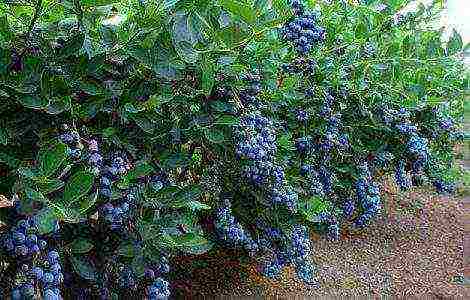1. Introduction
Man has long been planting beautiful plants in the house. Even large trees such as palm and lemon are planted. Almost no adult vegetable crops are grown in the room. Despite this, I decided to try to grow cucumbers indoors in order to find out for myself whether it is possible to get a small harvest of cucumbers from this method of growing.
I set a goal:
develop conditions for growing cucumbers at home.
My tasks:
study scientific and educational literature about the plant under study;
find out the conditions for growing cucumbers at home;
carry out practical work on growing cucumbers in room conditions;
set the time of sowing seeds;
to identify the effect of fertilizers on the growth, development of cucumber seedlings and ovaries cucumbers.
observe the plant under study.
Research hypothesis:
if you create the right conditions for growing cucumbers indoors, you can get a small harvest of cucumbers.
Research methods:
Search and analysis of literature on the problem
Internet browsing
Conversation with adults
Experimenting
Observation
Watching TV
1. 1. Information about the plant
From educational literature, I learned that cucumber is one of the most common vegetable crops. Cucumbers are good at any time of the year, they are eaten fresh, salted and pickled.
Cucumber is a thermophilic, moisture-loving plant, requires fertile soils, good illumination and wind protection. Pollination by bees is desirable, which increases productivity.
1. 2. History of growing cucumbers
My teacher and my parents told me that cucumbers are the most famous, light-loving and heat-loving vegetable. The optimal (one might say - the best) temperature for seed germination, plant growth and development is + 25 ° C, at temperatures below + 15 ° C, plant growth and development are delayed, the plant does not tolerate frost.
I learned from the Internet that the cucumber comes from India. In Russia, this culture became widely known in the 15th century.
To start growing cucumbers in indoor conditions, I had to carefully study the preparation of the soil for sowing seeds, to consider all the conditions for the development of seedlings. Choose the right seeds.
I learned that the soil contains nutrients, mineral fertilizers and fertilizing are used.
1. 3. Useful properties of cucumber
From the TV show, I learned that these vegetables have great nutritional, dietary and medicinal value. They contain a large amount of vitamins and other substances necessary for our body.
Today, medicine has proven that cucumber infusion is very useful for the body. It perfectly quenches thirst, eliminates dryness during illness, and has a good effect on digestion.
Having learned so many useful things, I decided to take action.
2. Experimental activities
for growing cucumbers indoors
I have carried out several experiments:
Experiment # 1: Preparing the soil for sowing.
I took cups for seedlings, put stones on the bottom, covered them with soil, then scalded the ground with boiling water so that unnecessary flea beetles and insects did not appear that could eat the roots of plants.
Then he brought cucumber seeds for the greenhouse.
First, I soaked the seeds to make them germinate.
When the seeds sprouted, I planted them in the ground.
The seeds sprouted very quickly, began to grow and develop.
Conclusion: To harvest cucumbers, you need to use greenhouse seeds.
All material - see the document.
Regional Competition
research works and creative projects
"Little Explorers"
for primary school students
educational institutions of the Astrakhan region
The world
Research work
on the topic:
"How to grow delicious cucumbers"
Performed:
b., 4th grade student
MKOU "Vodianovskaya secondary school"
Privolzhsky district.
Teacher: Dzhanmurzaeva Zulfira Murzabekovna.
Astrakhan - 2012
Plan.
1. Introduction.
2. The main part of "How to Grow Delicious Cucumbers".
1) Where to plant cucumbers?
2) The soil must be moistened.
3) Temperature conditions.
4) Care.
5) It is interesting.
3. Conclusion.
Introduction: I really love cucumbers. What a pleasure on a hot summer day to taste a fragrant, crispy cucumber, just picked from your own garden. There are probably no people in the world who would not like or at least not eat cucumbers - fresh or lightly salted, salted or pickled. Fresh are especially good. Strong, juicy, they increase appetite, improve the absorption of nutrients by the body
substances that reduce the acidity of gastric juice. And in winter and in spring they are not! It would be nice to grow them all year round.
Once, at the lesson of the surrounding world, we went through the topic "The development of a plant from a seed." My teacher and I sprouted cucumber seeds and planted them in a pot.
I wondered how they will grow, how they need to be properly cared for and what is necessary for the growth of the plant. For this I had to learn a lot: I read articles from the magazine "Household Economy", but my teacher Zulfira Murzabekovna told me a lot from her own experience.
Tasks:know how cultivated plants grow and whether it is possible to get fruits at home;
study the varieties of cucumbers, where and how they are grown.
Hypothesis: at home, you can grow cucumbers and get a harvest.
Research methods: reading special literature, caring for plants, observations, analysis.
The content of the work.
So I learned that the cucumber belongs to the pumpkin family, and warm India is considered to be its homeland, although since ancient times cucumbers have grown in Africa, and in Greece, and in the vast territory of the Roman Empire.
Cucumber is the only vegetable (and from the point of view of botany - a fruit) that we eat unripe. Cucumbers are very popular in vegetable salads, as well as in pickled or pickled form.
For numerous "merits" in 2007, a monument to a cucumber was even unveiled in Shklov (Belarus).
The length of the fruit ranges from 5 to 30 centimeters or more. The seeds are white. With proper storage, seeds do not lose their germination for 8-10 years.
I found that cucumber is a short-day plant that loves warmth, light and moisture. It consists of 95% water and contains sugar, as well as useful vitamins and minerals. Cucumber juice is one of the best natural skin care products out there.
I learned from books that cucumber varieties can be roughly divided into three groups:
hothouse - with long smooth fruits up to 30 centimeters or more;
garden beds - for open ground with fruits 10-15 centimeters in size;
gherkins - the size of the fruit does not exceed 10 cm.
So, during the research, I decided to answer many questions for myself: at what temperature do cucumber seeds germinate? What happens to plants when the temperature drops? Under what conditions do they grow and bear fruit better? Is the culture demanding on soil and air moisture?
First, I found out that the location of the planting of cucumbers should be well lit by the sun (partial shade is acceptable) and be protected from the wind.
Step 1. Where to plant cucumbers?
The soil, mixed with humus, we brought in in advance and warmed up to room temperature during the day. The soil for cucumbers should be loose and fertile. We decided to plant our cucumbers on the classroom windowsill, which was well-lit and sheltered from the wind.
The next day, March 15th, we sowed cucumber seeds in pots and put them on the windowsill. I watched them every day, when will they rise?
Our cucumbers sprouted on March 18!
Step 2. The soil must be moistened.
I found out that the cucumber loves water. Watering especially important for cucumbers during active growth and fruit formation.
Cucumbers should be watered with warm water (cold water leads to growth inhibition and the appearance of gray rot).
I had to water the plants every 2 days, as they dried out and the plants were lethargic. If the plant folded slightly the leaves, I watered it and immediately observed how these leaves unfold before our eyes.
With the appearance of the third true leaf in cucumbers, whips and leaves grow vigorously.
Step 3. Temperature conditions.
The optimum temperature for the normal development of cucumbers (like other pumpkin crops) ranges from 23-30 degrees. Air temperature below 15 degrees leads to oppression and cessation of plant growth at any stage of development.
I noticed, as soon as the heating in the classroom was turned off, and the air temperature outside did not exceed 10 degrees, the growth of our plant stopped.
Step 4. Leaving.
Caring for cucumbers is reduced to weeding, watering, fertilizing (if necessary) and garter on trellises.
With the onset of a stable air temperature of about 20 degrees, our plants began to grow actively.
On April 28, I saw the first three flowers on cucumbers. And the next day, the number of flowers increased to ten.
After the holidays, on May 3, I noticed that the first ovaries on cucumbers increased and reached 5 centimeters.
Step 5. The root system of cucumbers needs air!
In order for the roots of the cucumbers to breathe, I had to carefully loosen the soil around the plants so as not to damage the roots.
|
Step 6. Give the cucumbers room to grow! My cucumbers grew on the windowsill. To keep them growing normally, I tied them up and they started to grow in height. I had only three roots in the box, and that was enough for them to grow. |
The "bitter" truth about cucumbers.
Sometimes, cucumbers are bitter. It turns out that most cucumber plants contain substances called cucurbitacins, which are responsible for the bitter taste of the fruit. With a low content of these substances, bitterness is invisible, but if there are many of them, a cucumber can be very bitter - so bitter that it is impossible to eat it. When the cucumber plant is stressed, the cucurbitacin content rises. And the stress for a cucumber, as I understand it, is a drop in temperature, a lack of light hours or moisture.
The bitterness-free varieties have a mild taste. These are varieties such as "Courage" or "Quadrille". Imagine my surprise when my cucumbers turned out to be tasty and without bitterness!
Step 7. Collect cucumbers correctly!
Some gardeners, picking cucumbers, break off the whip with a quick movement. Cucumbers must be picked carefully without damaging the whip.
The more often you pick cucumbers, the faster the others grow.
It is interesting!
In the course of research, I learned that inquisitive people have long been interested in the question of whether vegetables can be cultivated in basements, cellars, in general in underground workings. The first experiments, says the magazine "Household Economy" (N2 1, 1986), were carried out in 1875. Kerosene lamps, gas burners and other primitive means served as the light source. Currently, modern incandescent lamps are used.
The results of experiments carried out in underground rooms have surpassed all expectations. Thus, in the laboratory of photophysiology and photoculture of plants of the Agrophysical Research Institute, the professor received an unprecedented crop of tomatoes during the year.
The air temperature, its chemical composition, atmospheric pressure in underground workings are close to the outer ones. All this is very useful for growing vegetables in cellars and basements, especially vegetables such as onions (per feather), sorrel, lettuce, dill. But for cucumbers and tomatoes, the underground technology had to be "adjusted".
The difficulty was presented by the light regime. It turned out that the duration of a day underground should be no more than 18 hours. Cucumbers need 10 light hours of "day", tomatoes -12.
Step 8. Drawing conclusions.
So, in the course of my research, I answered all my questions and made the following conclusions:
1. Cucumber seeds germinate at a temperature of 12 degrees, but the most favorable temperature for germination is 24-30 degrees.
2. With a decrease in temperature to less than 10 degrees, growth stops for a long time, they are exposed to various diseases and do not give a crop.
3. Cucumbers can be grown not only in the ground, but also on a well-lit windowsill.
4. They grow and bear fruit best at an air temperature of 25-32 degrees, soil - 20-25 degrees.
5. Plants need constant watering.
6. They must be weeded systematically.
7. Self-grown cucumbers turn out to be much tastier!
8. They can also be grown in basements.
9. After conducting our research work, we came to the conclusion that it is better to carry out such work in the school greenhouse, which is in our school.
References:
1. Aleksashin, on vegetable growing. 2nd ed. revised and add. /, A. B. Alpatiev, P. A. Andreeva. D .: Kolos, 198p.
2. Leopold, A. Growth and development of plants / A. Leopold - M .: Mir, 19p.
3. Nikolaev, cucumber in the winter-spring turnover in the Federal State Unitary Enterprise "Sovkhoz" Teplichny "/ // Gavrish. 2007. - No. 6. - S. 12-15.81. Nikolaev, fruits and vegetables / M .:
4. Magazine "Household economy" (N2 1, 1986)
5. Internet resources
Svetlana Lovygina
Research work "Conditions for growing green onions"
Introduction
Why did I decide to find out under what onion grows better in conditions?
Winter is on the street. There is snow all around, severe frost, little sunshine. In winter, many children and adults often get colds. We often have to hear: "Eat more vitamins"... How to replenish your body with vitamins? It turns out that the easiest way is to eat green onions.
In our kindergarten, every winter and spring we organize a vegetable garden on the windowsill - grow green onions... Children put soil in special containers, plant bulbs, take care of them. And after a while, the mini-garden pleases us with bright green feathers Luke... With special pride, we cut feathers and take them to the kitchen, where the chef adds them to various dishes - soups, salads. We believe that our work benefits all the children of our kindergarten.
During cultivation and observing the growth Luke, the guys and I came to the conclusion that for his good growth, a number of conditions, this is soil, water, heat, light.
Is it possible grow onions without soil? How will it develop in the absence of, for example, light or water? I decided to carry out a series of experiments.
The purpose of my research: the influence of different conditions for the process of growing green onions.
Tasks:
1. Find out where the bow came to us.
2. Explore conditions for the growth and development of plants.
3. Pick up the necessary materials.
4. Grow onions.
Hypothesis: suppose that if we put the onion in water and put it on the windowsill, where the sun is, then it will grow up soonerthan onions placed in a dark place, and in the absence of water, the onions will not grow at all.
An object research: onion.
Item research: conditions for growing green onions in the room.
Methods: study the literature, conduct an experiment, observe, analyze.
Plan work:
1. Find information about growing green onions.
2. Plant onions.
3. Take care of the plantings.
4. Document the results of the experiment.
Main part.
1. Where did the onions come from?
Onions are one of the most ancient vegetable plants. His grow for five millennia. Cultivation Luke began in ancient China, and then passed to India and Egypt. Leftovers Luke archaeologists have found in the Egyptian pyramids, and on the sarcophagi and walls of buildings - a variety of his images.
In ancient Greece and Rome, warriors used onions in large quantities, because they were sure that it gives them strength and courage.
In the Middle Ages, people believed in the ability Luke protect from arrows and swords. Medieval knights wore a simple onion on their chest as a talisman.
And at all times, healing properties were attributed to onions. The ancient Slavs used it for many diseases, and during the years of severe epidemics in the huts they hung bundles Luke.
2. Conditions growth and development of plants.
My I started work withthat he turned to his mother for help. We went to the village library with her and got acquainted with the literature on growing plants... From books I learned that for the full growth and development of plants, the following are necessary conditions:
• Warmly
• Light
• Water
• Minerals
• Air
Water is the source of life. The plant is 80% water. Plants need water for their full growth. All plants drink water and receive nutrients with it. Water is found in leaves, stems, fruits. Plants are cooled by evaporating water through the leaves.
Sunlight is one of the most important factors for plant life. Only in the light in the leaves of plants goes the necessary for their life process:
- plant leaves absorb carbon dioxide from the air,
- the roots absorb water from the soil,
- with the help of solar energy, carbon dioxide and water interact in the leaves.
As a result of this process, plant nutrients are produced and oxygen is released.
This process is called photosynthesis.
Under the influence of sunlight, the green pigment chlorophyll is also formed in plants.
I decided to check all this scientific information on my own experience.
3. Growing green onions... Experiment.
The most unpretentious plant for distillation greens - onions. Greens can be grown in any room and on the shortest winter days. It is obtained by using the nutrient reserves stored in the bulb. Green onions are an irreplaceable source of vitamin C, especially necessary for the human body in winter.
The experiment started on 02/01/2017 and finished on 02/28/2017
For research I turned to the guys in my group for help. We are divided into 3 teams to grow onions in different conditions.
For work we have prepared:
• Glass jars with conventions
• Water.
• Bulbs (trimmed at the top and bottom so that the roots and greens appeared sooner)
1 team - landing Luke in the presence of the following conditions: light, heat, water.
• Fill the jar with water.
• Put the onion head into the hole onion roots down.
• Placed on the windowsill.
Team 2 - landing Luke in the presence of the following conditions: heat, water, no light
• Fill the jar with water.
• Put the onion head into the hole onion roots down.
• Placed in a dark place.
3 team - landing Luke in the presence of the following conditions: warmth, light, no water.
• We took a jar
• Put the onion head into the hole onion roots down.
• Placed on a windowsill.
Onion plantings with water almost did not require maintenance, they only made sure that the roots that appeared were in the water. We changed the water.
During the observation, the teams noticed changes in the growth of the bulbs, discussed them and sketched them in the observation log.
Exploring the results of the experiments of the teams, the guys and I came to the following conclusions:
1. Onions are a source of vitamins.
2. Bow can to grow in winter, not only in the ground, but also in the water.
3. For fast growth, onions need the following conditions: light, heat, water.
4. To get sick less often, you need to eat green onions.
Conclusion
In winter, when the ground is covered with snow and ice, I managed to grow there is a beautiful green onion on the windowsill. It took me very little time to achieve the result - one month.
My hypothesis that a bow can be grow not only in the groundbut also water, was confirmed.
The guys were carried away by the idea cultivation healthy vegetables on the windowsill, many of them decided grow onions at home.
In the group, our mini garden on the windowsill expanded, we sowed dill and parsley seeds, we plan to sow indoor tomatoes and cucumbers
Yes, a good onion has grown.
Everything has happened. But not suddenly.
We planted the onion together.
The plantings were monitored.
A green, strong onion has grown,
Cure all ailments!
Sources of
1.N.A.Bluket, L.S.Roman, S.A.Puzanova "Botany with the basics of plant physiology" Moscow "Ear" 1975
2.V. V. Chub "Plant growth and development"
3.G.S. Noga "Experiments and observations of plants" Moscow "Education" 1987
4. Articles from the Internet
• "History of appearance Luke»
• "Bow for seven ailments"
Municipal state educational institution
"Gavrilovskaya secondary school"
Research work
Environmental project
"Onion is a green friend"
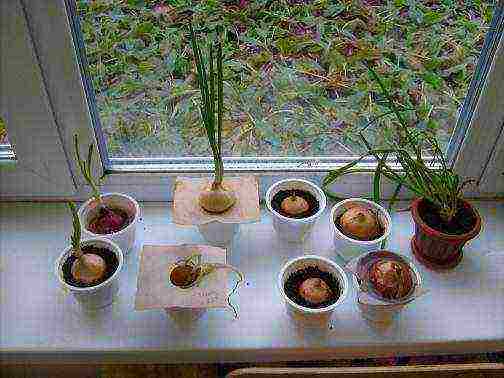
Performers: Grade 3 students
and teacher
• Project type - creative, collective, short-term.
• Performers - grade 3 students and a teacher.
• Nature of the project - educational research work.
• Target: grow green onions, get the research skill
Project objectives:
ü Arouse children's interest in project activities, since it makes it possible to:
Ø Show creativity in thinking
Ø Learn the elements of search work
Ø To learn how to search for information, its analysis, structuring.
Relevance of the topic: the subject-content area of the project united all the subjects studied in elementary school, their interdependent connections.
Practical focus of the project that every child has grown green onion feathers.
Structure - a block of theoretical knowledge, practical activity, experimental work.
The dominant activity in the project is educational and research, creative and search.
v Project stages
Long-term plan
1. Collecting information about onions, riddles and poems about onions, planting and growing onions in various conditions.
2. Learning poems about onions, a conversation about ways to grow onions.
3. Composing stories and tales about onions, riddles, observing changes in the plant, observing onion growth and recording observations in journals, completing experimental activities.
Topic: Planting Onions
Program content: to expand children's knowledge about the beneficial properties of onions; consolidate knowledge about the conditions for growing plants; develop curiosity, bring up responsibility for the assigned task.
Material: onions for each child, containers for planting onions for each child (plastic cups); earth, a kettle with water, small spatulas (for those who will plant onions in the ground, halves of notebooks, scissors, simple pencils for each child;
- I suggest that you turn into real scientists and conduct an experiment on growing onions in various conditions. You will grow onions in the dark, cold, warm, and under normal conditions on a windowsill. Some guys will grow onions in the water, others in the ground. Before starting work, think about the conditions in which each of you would like to grow your bulb, and divide into teams. One team should include those who want to grow onions in the dark, in the other, those who will grow onions in the warmth, etc. In each team, the guys will grow onions both in water and in the ground.
Children are divided into teams on their own. The teacher distributes to each child an onion, cups, pots of soil, scissors, pencils, half of a notebook. Within the teams, children decide which of them will grow onions in the ground and who in the water. Then, with the help of scissors, they cut the bulbs upwards, in order for the sprouts to appear faster, pour water into cups or plant the bulb in the ground and water it. After planting the onions, the children make the inscription "Scientific Journal" on their notebooks and write their first and last names. Then, in the notebooks themselves, they write down the date of planting the onions, and in what conditions they are grown. For those who find it difficult, the teacher writes on the board.
For example:
15.10 Planting a bow. We grow in the dark (warm, cold, under normal conditions).
They poured the onion.
23.10 A sprout appeared.
In the future, each child independently takes care of his plant, watering it and making appropriate notes and sketches in his scientific journal.
Topic: "Useful properties of onions"
Program content: to acquaint with the beneficial properties of onions, methods of using them in the treatment of various diseases, develop creativity when showing a scene, instill interest in information about onions.

Scene "Bow is my friend"


Doctor's advice "Onion for seven ailments"
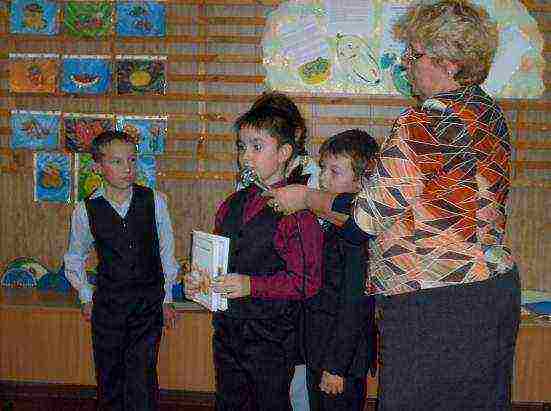

Books - babies about onions (poems, riddles, proverbs)
PROJECT PRESENTATION
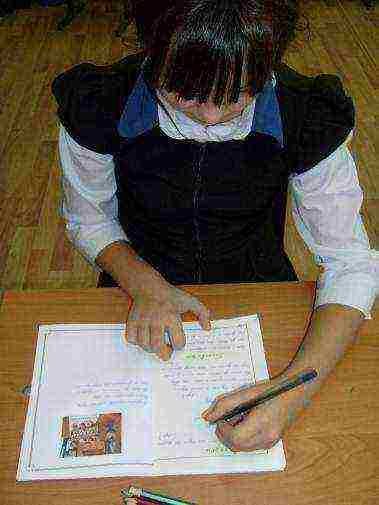



Delicious green onions!
Topic: "Three brothers onion"
Program content: to acquaint children with the stages of onion growing; give an idea of the different varieties of onions; consolidate knowledge about the beneficial properties of the vegetable; instill an interest in a healthy lifestyle.
Material: onion seeds; sets of white, yellow and red; onion heads of red, white and yellow; a picture of a flowering onion, sheets of paper for each child, pencils or paints.
Fairy tale "Three brothers".
“The boy Ilyushka was at the dacha. He sat on a bench and dangled his leg. Suddenly three boys ran up to Ilya: one - small and black, the other - bigger, in a golden suit, and the third - the largest, ruddy and strong, in golden armor with a large green onion in his hands.
- Chernushka onion, Sevok onion, Onion Onion, - they bowed in turn to Ilyushka and said:
- We are all brothers, we came to check if everything is all right with you. After all, we bows are famous defenders, like our brother Garlic.
- Who are you protecting? The boy asked.
“Everyone: vegetables from pests, people from microbes, a home from troubles and diseases,” onions answered proudly.
- What good fellows you are, I would also like to be such a brave defender.
- It's very simple: you just need to take care of those who are next to you, - explained the little onion Chernushka, - I, for example, the smallest, simple onion seed, but without me our middle brother - the onion Sevok will not grow. They put me in a garden bed, and I immediately begin to grow a golden suit and green feathers for him. So that everyone can see that my feathers are ready to help anyone, I bend my very first stalk in the form of a bow. "
“Without me, our elder brother, Onions, will never grow,” said the onion Sevok. - As soon as they put me in the ground in the spring, I begin to make copper armor for my copper brother: I grow many, many scales and large succulent feathers in the bulb for him. My green feathers in the spring are the first to save a person from vitamin deficiency! "
“I, everything that my younger brothers gave me, must give to the people and to my brothers for their care should be repaid with kindness,” said the Onion. “In each scale I have thousands of volatile volatile warriors. As soon as I see that harmful microbes are preparing to attack someone, I immediately release my soldiers. They drive all microbes away without looking back. Eat me more often, Ilyusha, and not a single harmful microbe will touch you. "
“- How do you return goodness to your brothers? - Ilyushka asked.
- In order for our family not to stop, I release an arrow and grow a white spherical inflorescence on it. It is from him that my younger brothers grow - black seeds. But I do not always manage to raise my brothers in the first summer. If the summer is short, I don't have time to bloom. It happens 2-3 years pass before I can grow seeds.
“How friendly you are,” said Ilyushka with respect.
- There are three of us brothers in the genus of the Onion Onion, and in total there are about four hundred brothers-onions in the onion family, and they are all friends, the Onion Onion laughed "
Topic: "What happened to the bow in a month"
Program content: review and compare bows one month after planting; identify the difference in the appearance of onions grown in different conditions and the reasons for this; fix the structure of the plant; develop curiosity, creative imagination.
Material: onions grown by children for a month; bulb; sheets of paper for each child, colored paper, glue, scissors, napkins.
one.The structure of the bow.
Distribution into groups according to onion growing conditions.
Look at the bulb in my hands and your bulbs, are there any differences among them, what are they? (roots appeared, onion arrows grew, the bulb itself became softer)
2. Comparison of plants grown under different conditions.
Children take turns looking at onions grown in the dark, in the cold, in the warm, under normal conditions, and compare the appearance.
- Feathers of onions grown in the dark, pale, why (not enough light?)
- Onions growing in the cold gave still small shoots, onion feathers are dark, but not high, why (there is not enough heat)
- Onions growing in the warmth (near the battery) are not the same: some bulbs practically did not sprout (there is not enough water, moisture evaporates quickly, the owners had to water more often, the green arrows of other bulbs withered (they were burned).
- The arrows of the onion growing on the windowsill are the highest and most powerful, bright green; all the bulbs gave shoots (all the conditions for growing plants are met, the plant receives enough light and heat, requires moderate watering).
-Summarizing. (Favorable conditions required for successful plant cultivation).
Experiment
1. Bow at the beginning of the project
1.a. warm-grown

1. b. cold-grown

1. in. grown in the dark

1.Growed under normal conditions

2. Onions in a month
2.a. warm-grown
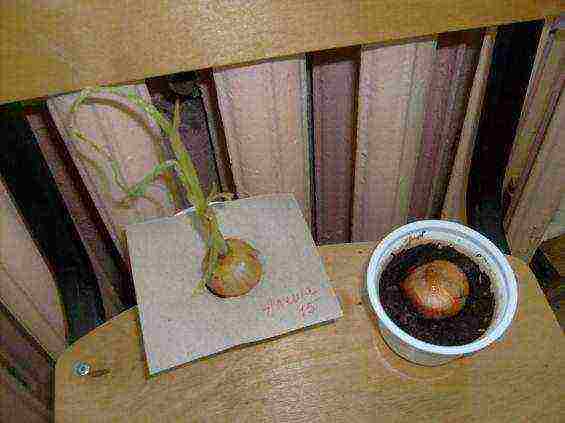
2. b. cold-grown
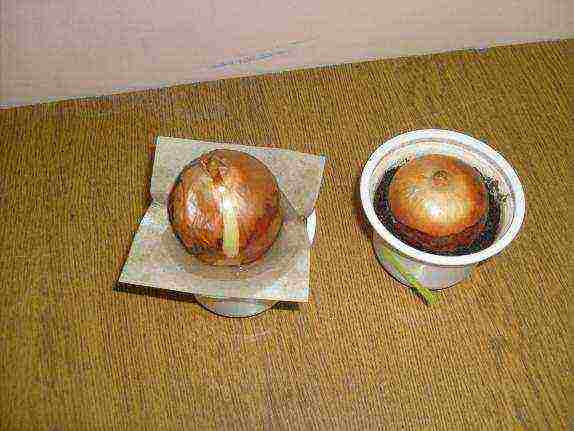
2.c. grown in the dark

2.Growed under normal conditions

See full lists: Professions
Text of this presentation
Slide 1
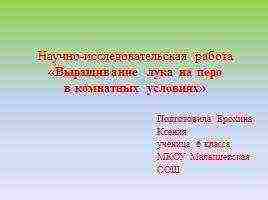
Research work "Growing onions on a feather in indoor conditions"
Prepared by Erokhina Ksenia, student of the 6th grade of MKOU Malyshevskaya secondary school
Slide 2
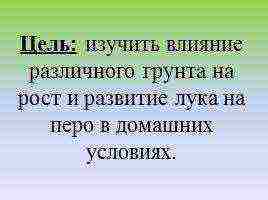
Objective: to study the effect of different soil on the growth and development of onions on a feather at home.
Slide 3

Tasks: 1. Choose a different soil for the experiment. 2. Assess the influence of different soil on the growth and development of onions. 3. Learn about the benefits of onions and their uses, cultural history. 4. Determine the necessary conditions and methods for growing onions on a feather. 5. Observe the growth of green onions. 6. Study the literature on this issue.
Slide 4
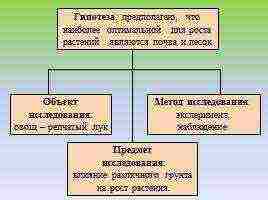
Hypothesis: I assume that soil and sand are the most optimal for plant growth
Research object: vegetable - onion
Subject of research: the influence of different soil on the growth of a plant.
Research method: experiment, observation
Slide 5

They began to grow onions 4 thousand years before our era. The ancient Greeks revered onions as a plant that brought health. In Europe, onions were originally used as a seasoning, then they became indispensable for daily nutrition. The most important part of the plant is the bulb. It contains many vitamins necessary for human health. Especially a lot of vitamin C in green onion leaves, which are often eaten raw.
Slide 6
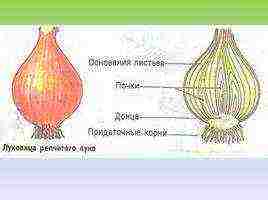
Slide 7

For the experiment, plastic containers of equal volume and bulbs of approximately the same size were prepared.
Slide 8

Slide 9

I numbered the pots: under number 1 - soil; No. 2 - sand and No. 3 - clay.
Slide 10

Observations and measurements were carried out for 24 days.
Slide 11
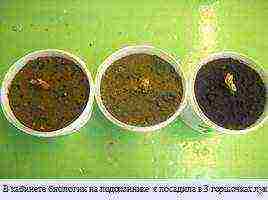
In the biology office, on the windowsill, I planted onions in 3 pots.
Slide 12
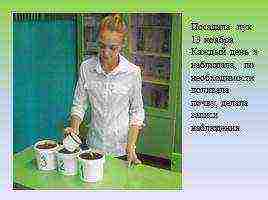
I planted onions on November 13. Every day I watched, irrigated the soil as needed, made notes of observation.
Slide 13

Slide 14

5 days after planting, the onion sprouted in the sand. After 7 days - in the soil. But it didn’t grow in the clay.
Slide 15

Slide 16

At the end of the work, the feathers of onions grown in the soil grew the highest. (60 cm, pot number 1). In second place is the height of the onion that grew in the sand (40 cm, pot number 2). In a pot of clay, the onion did not sprout (0 cm, pot number 3).
Slide 17
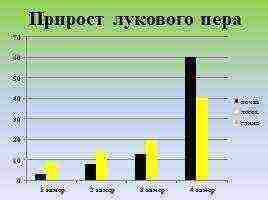
Onion Feather Growth
Slide 18
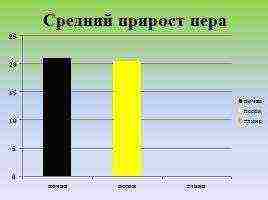
Slide 19

Thank you for your attention!
Author of the publication: Lazareva E.A.
Date of publication: 25.09.2016
Short description:
MOU Taiturskaya secondary school Project: “Vegetable garden.Cultivation of cucumbers "Completed by: Pupil 3 A class Evgeniya Byrgazova Supervisor: Lazareva Е.А.
Purpose: Growing cucumbers Objectives: To study the literature on this issue Buy seeds Determine a place for growing cucumbers Prepare land for planting
Thanks to this advertisement, the site can continue to exist, thanks for watching.
Terms of project implementation: From April to July 2015 Expected result Obtaining a harvest of cucumbers
Practical implementation of the project We have chosen different varieties of cucumbers. We have prepared a place for planting. Cucumbers were planted on April 20 Cucumber varieties
The first shoots appeared on April 25
On April 29, the third leaf appeared in cucumbers
Cucumbers grew very quickly To prevent the plants from falling, we tied them up
The first crop was harvested on June 1
Summing up In total, 30 kg of cucumbers were harvested. The cost is 1,500 thousand rubles. The project can be considered successful !!! In the future, we plan to continue working on growing cucumbers.


